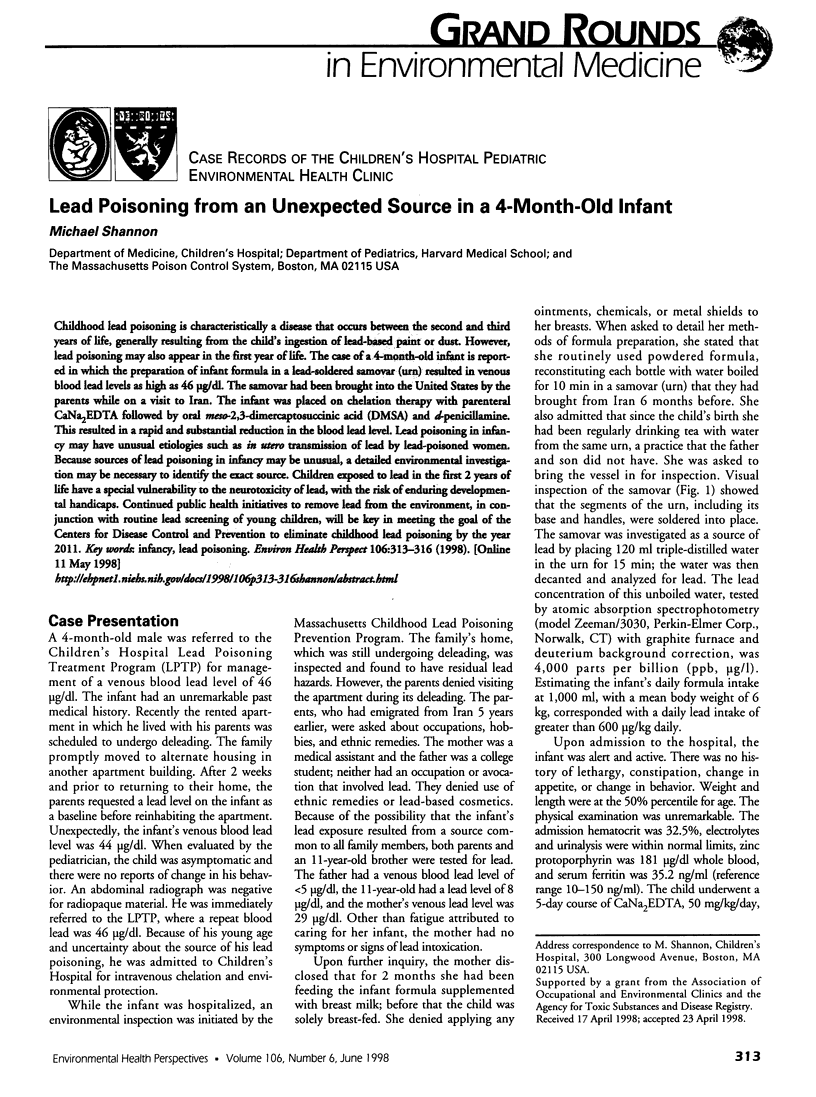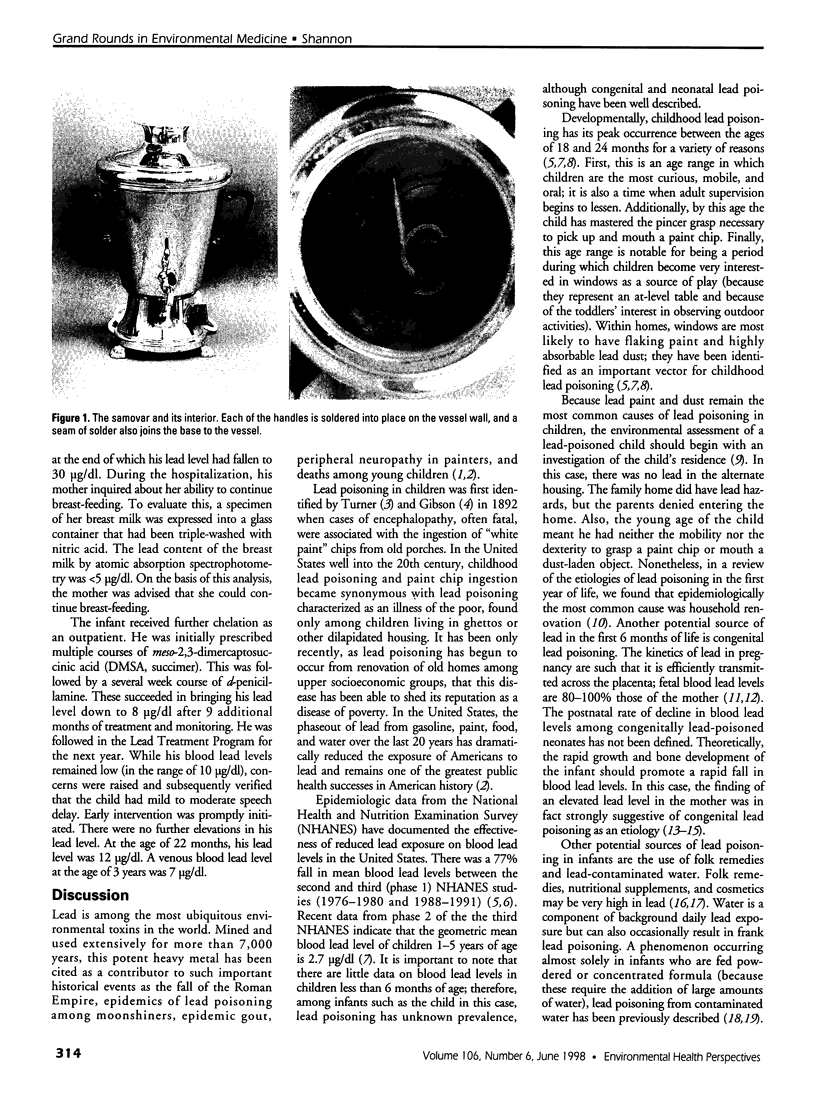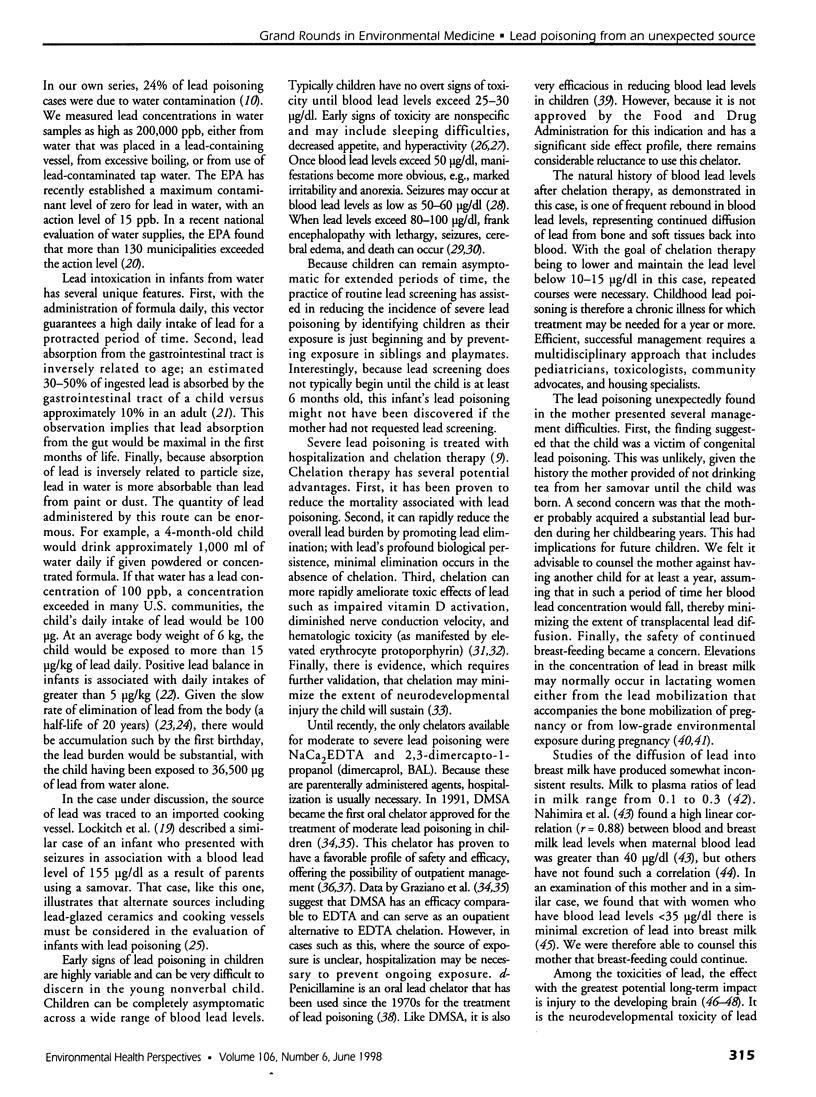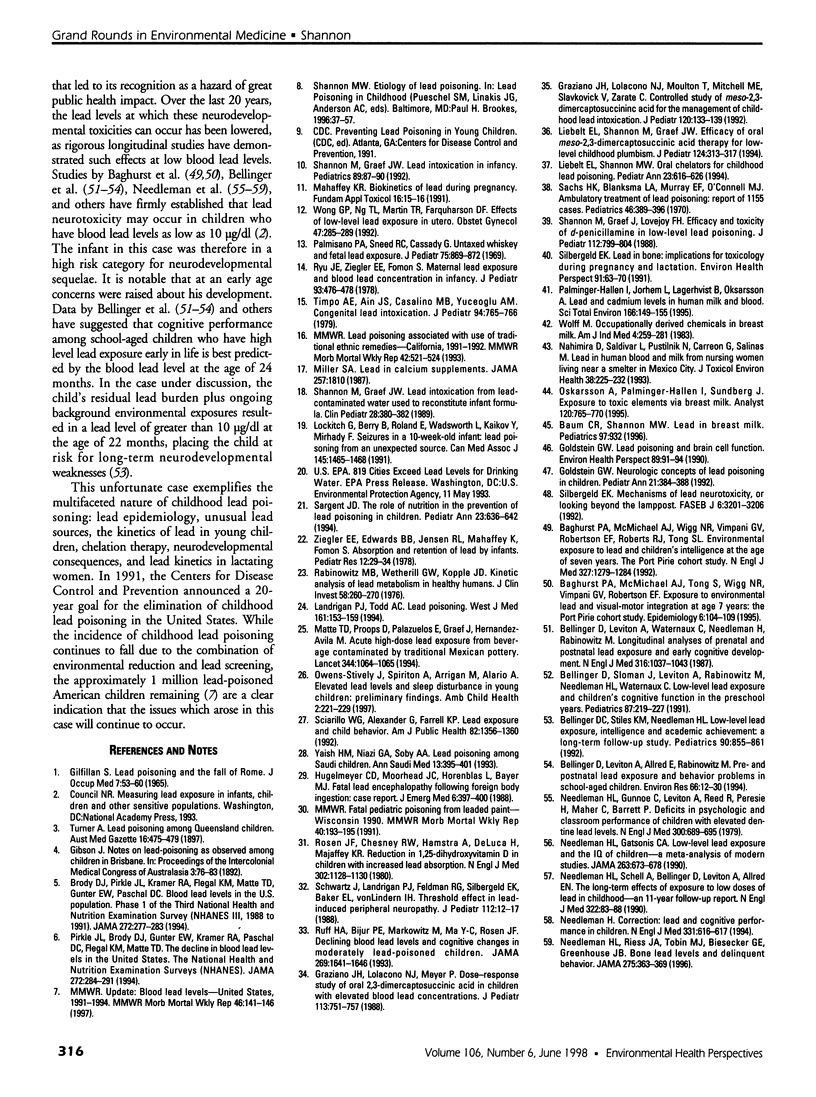Abstract
Childhood lead poisoning is characteristically a disease that occurs between the second and third years of life, generally resulting from the child's ingestion of lead-based paint or dust. However, lead poisoning may also appear in the first year of life. The case of a 4-month-old infant is reported in which the preparation of infant formula in a lead-soldered samovar (urn) resulted in venous blood lead levels as high as 46 microg/dl. The samovar had been brought into the United States by the parents while on a visit to Iran. The infant was placed on chelation therapy with parenteral CaNa2EDTA followed by oral meso-2,3-dimercaptosuccinic acid (DMSA) and d-penicillamine. This resulted in a rapid and substantial reduction in the blood lead level. Lead poisoning in infancy may have unusual etiologies such as in utero transmission of lead by lead-poisoned women. Because sources of lead poisoning in infancy may be unusual, a detailed environmental investigation may be necessary to identify the exact source. Children exposed to lead in the first 2 years of life have a special vulnerability to the neurotoxicity of lead, with the risk of enduring developmental handicaps. Continued public health initiatives to remove lead from the environment, in conjunction with routine lead screening of young children, will be key in meeting the goal of the Centers for Disease Control and Prevention to eliminate childhood lead poisoning by the year 2011.
Full text
PDF



Images in this article
Selected References
These references are in PubMed. This may not be the complete list of references from this article.
- Baghurst P. A., McMichael A. J., Tong S., Wigg N. R., Vimpani G. V., Robertson E. F. Exposure to environmental lead and visual-motor integration at age 7 years: the Port Pirie Cohort Study. Epidemiology. 1995 Mar;6(2):104–109. doi: 10.1097/00001648-199503000-00003. [DOI] [PubMed] [Google Scholar]
- Baghurst P. A., McMichael A. J., Wigg N. R., Vimpani G. V., Robertson E. F., Roberts R. J., Tong S. L. Environmental exposure to lead and children's intelligence at the age of seven years. The Port Pirie Cohort Study. N Engl J Med. 1992 Oct 29;327(18):1279–1284. doi: 10.1056/NEJM199210293271805. [DOI] [PubMed] [Google Scholar]
- Baum C. R., Shannon M. W. Lead in breast milk. Pediatrics. 1996 Jun;97(6 Pt 1):932–932. [PubMed] [Google Scholar]
- Bellinger D. C., Stiles K. M., Needleman H. L. Low-level lead exposure, intelligence and academic achievement: a long-term follow-up study. Pediatrics. 1992 Dec;90(6):855–861. [PubMed] [Google Scholar]
- Bellinger D., Leviton A., Allred E., Rabinowitz M. Pre- and postnatal lead exposure and behavior problems in school-aged children. Environ Res. 1994 Jul;66(1):12–30. doi: 10.1006/enrs.1994.1041. [DOI] [PubMed] [Google Scholar]
- Bellinger D., Leviton A., Waternaux C., Needleman H., Rabinowitz M. Longitudinal analyses of prenatal and postnatal lead exposure and early cognitive development. N Engl J Med. 1987 Apr 23;316(17):1037–1043. doi: 10.1056/NEJM198704233161701. [DOI] [PubMed] [Google Scholar]
- Bellinger D., Sloman J., Leviton A., Rabinowitz M., Needleman H. L., Waternaux C. Low-level lead exposure and children's cognitive function in the preschool years. Pediatrics. 1991 Feb;87(2):219–227. [PubMed] [Google Scholar]
- Brody D. J., Pirkle J. L., Kramer R. A., Flegal K. M., Matte T. D., Gunter E. W., Paschal D. C. Blood lead levels in the US population. Phase 1 of the Third National Health and Nutrition Examination Survey (NHANES III, 1988 to 1991) JAMA. 1994 Jul 27;272(4):277–283. doi: 10.1001/jama.272.4.277. [DOI] [PubMed] [Google Scholar]
- GILFILLAN S. C. LEAD POISONING AND THE FALL OF ROME. J Occup Med. 1965 Feb;7:53–60. [PubMed] [Google Scholar]
- Goldstein G. W. Neurologic concepts of lead poisoning in children. Pediatr Ann. 1992 Jun;21(6):384–388. doi: 10.3928/0090-4481-19920601-11. [DOI] [PubMed] [Google Scholar]
- Graziano J. H., Lolacono N. J., Moulton T., Mitchell M. E., Slavkovich V., Zarate C. Controlled study of meso-2,3-dimercaptosuccinic acid for the management of childhood lead intoxication. J Pediatr. 1992 Jan;120(1):133–139. doi: 10.1016/s0022-3476(05)80618-3. [DOI] [PubMed] [Google Scholar]
- Hallén I. P., Jorhem L., Lagerkvist B. J., Oskarsson A. Lead and cadmium levels in human milk and blood. Sci Total Environ. 1995 Apr 21;166:149–155. doi: 10.1016/0048-9697(95)04523-4. [DOI] [PubMed] [Google Scholar]
- Hugelmeyer C. D., Moorhead J. C., Horenblas L., Bayer M. J. Fatal lead encephalopathy following foreign body ingestion: case report. J Emerg Med. 1988 Sep-Oct;6(5):397–400. doi: 10.1016/0736-4679(88)90013-3. [DOI] [PubMed] [Google Scholar]
- Landrigan P. J., Todd A. C. Lead poisoning. West J Med. 1994 Aug;161(2):153–159. [PMC free article] [PubMed] [Google Scholar]
- Liebelt E. L., Shannon M. W. Oral chelators for childhood lead poisoning. Pediatr Ann. 1994 Nov;23(11):616-9, 623-6. doi: 10.3928/0090-4481-19941101-10. [DOI] [PubMed] [Google Scholar]
- Liebelt E. L., Shannon M., Graef J. W. Efficacy of oral meso-2,3-dimercaptosuccinic acid therapy for low-level childhood plumbism. J Pediatr. 1994 Feb;124(2):313–317. doi: 10.1016/s0022-3476(94)70326-4. [DOI] [PubMed] [Google Scholar]
- Lockitch G., Berry B., Roland E., Wadsworth L., Kaikov Y., Mirhady F. Seizures in a 10-week-old infant: lead poisoning from an unexpected source. CMAJ. 1991 Dec 1;145(11):1465–1468. [PMC free article] [PubMed] [Google Scholar]
- Mahaffey K. R. Biokinetics of lead during pregnancy. Fundam Appl Toxicol. 1991 Jan;16(1):15–16. doi: 10.1016/0272-0590(91)90127-p. [DOI] [PubMed] [Google Scholar]
- Namihira D., Saldivar L., Pustilnik N., Carreón G. J., Salinas M. E. Lead in human blood and milk from nursing women living near a smelter in Mexico City. J Toxicol Environ Health. 1993 Mar;38(3):225–232. doi: 10.1080/15287399309531714. [DOI] [PubMed] [Google Scholar]
- Needleman H. L. Correction: lead and cognitive performance in children. N Engl J Med. 1994 Sep 1;331(9):616–617. doi: 10.1056/NEJM199409013310915. [DOI] [PubMed] [Google Scholar]
- Needleman H. L., Gatsonis C. A. Low-level lead exposure and the IQ of children. A meta-analysis of modern studies. JAMA. 1990 Feb 2;263(5):673–678. [PubMed] [Google Scholar]
- Needleman H. L., Gunnoe C., Leviton A., Reed R., Peresie H., Maher C., Barrett P. Deficits in psychologic and classroom performance of children with elevated dentine lead levels. N Engl J Med. 1979 Mar 29;300(13):689–695. doi: 10.1056/NEJM197903293001301. [DOI] [PubMed] [Google Scholar]
- Needleman H. L., Riess J. A., Tobin M. J., Biesecker G. E., Greenhouse J. B. Bone lead levels and delinquent behavior. JAMA. 1996 Feb 7;275(5):363–369. [PubMed] [Google Scholar]
- Oskarsson A., Palminger Hallén I., Sundberg J. Exposure to toxic elements via breast milk. Analyst. 1995 Mar;120(3):765–770. doi: 10.1039/an9952000765. [DOI] [PubMed] [Google Scholar]
- Pirkle J. L., Brody D. J., Gunter E. W., Kramer R. A., Paschal D. C., Flegal K. M., Matte T. D. The decline in blood lead levels in the United States. The National Health and Nutrition Examination Surveys (NHANES) JAMA. 1994 Jul 27;272(4):284–291. [PubMed] [Google Scholar]
- Rabinowitz M. B., Wetherill G. W., Kopple J. D. Kinetic analysis of lead metabolism in healthy humans. J Clin Invest. 1976 Aug;58(2):260–270. doi: 10.1172/JCI108467. [DOI] [PMC free article] [PubMed] [Google Scholar]
- Rosen J. F., Chesney R. W., Hamstra A., DeLuca H. F., Mahaffey K. R. Reduction in 1,25-dihydroxyvitamin D in children with increased lead absorption. N Engl J Med. 1980 May 15;302(20):1128–1131. doi: 10.1056/NEJM198005153022006. [DOI] [PubMed] [Google Scholar]
- Ruff H. A., Bijur P. E., Markowitz M., Ma Y. C., Rosen J. F. Declining blood lead levels and cognitive changes in moderately lead-poisoned children. JAMA. 1993 Apr 7;269(13):1641–1646. [PubMed] [Google Scholar]
- Ryu J. E., Ziegler E. E., Fomon S. J. Maternal lead exposure and blood lead concentration in infancy. J Pediatr. 1978 Sep;93(3):476–478. doi: 10.1016/s0022-3476(78)81169-x. [DOI] [PubMed] [Google Scholar]
- Sachs H. K., Blanksma L. A., Murray E. F., O'Connell M. J. Ambulatory treatment of lead poisoning: report of 1,155 cases. Pediatrics. 1970 Sep;46(3):389–396. [PubMed] [Google Scholar]
- Sargent J. D. The role of nutrition in the prevention of lead poisoning in children. Pediatr Ann. 1994 Nov;23(11):636–642. doi: 10.3928/0090-4481-19941101-12. [DOI] [PubMed] [Google Scholar]
- Schwartz J., Landrigan P. J., Feldman R. G., Silbergeld E. K., Baker E. L., Jr, von Lindern I. H. Threshold effect in lead-induced peripheral neuropathy. J Pediatr. 1988 Jan;112(1):12–17. doi: 10.1016/s0022-3476(88)80111-2. [DOI] [PubMed] [Google Scholar]
- Sciarillo W. G., Alexander G., Farrell K. P. Lead exposure and child behavior. Am J Public Health. 1992 Oct;82(10):1356–1360. doi: 10.2105/ajph.82.10.1356. [DOI] [PMC free article] [PubMed] [Google Scholar]
- Shannon M. W., Graef J. W. Lead intoxication in infancy. Pediatrics. 1992 Jan;89(1):87–90. [PubMed] [Google Scholar]
- Shannon M., Graef J. W. Lead intoxication from lead-contaminated water used to reconstitute infant formula. Clin Pediatr (Phila) 1989 Aug;28(8):380–382. doi: 10.1177/000992288902800810. [DOI] [PubMed] [Google Scholar]
- Shannon M., Graef J., Lovejoy F. H., Jr Efficacy and toxicity of D-penicillamine in low-level lead poisoning. J Pediatr. 1988 May;112(5):799–804. doi: 10.1016/s0022-3476(88)83212-8. [DOI] [PubMed] [Google Scholar]
- Silbergeld E. K. Mechanisms of lead neurotoxicity, or looking beyond the lamppost. FASEB J. 1992 Oct;6(13):3201–3206. doi: 10.1096/fasebj.6.13.1397842. [DOI] [PubMed] [Google Scholar]
- Timpo A. E., Amin J. S., Casalino M. B., Yuceoglu A. M. Congenital lead intoxication. J Pediatr. 1979 May;94(5):765–767. doi: 10.1016/s0022-3476(79)80149-3. [DOI] [PubMed] [Google Scholar]
- Wolff M. S. Occupationally derived chemicals in breast milk. Am J Ind Med. 1983;4(1-2):259–281. [PubMed] [Google Scholar]
- Wong G. P., Ng T. L., Martin T. R., Farquharson D. F. Effects of low-level lead exposure in utero. Obstet Gynecol Surv. 1992 May;47(5):285–289. doi: 10.1097/00006254-199205000-00001. [DOI] [PubMed] [Google Scholar]
- Yaish H. M., Niazi G. A., Al Soby A. Lead poisoning among Saudi children. Ann Saudi Med. 1993 Sep;13(5):395–401. doi: 10.5144/0256-4947.1993.395. [DOI] [PubMed] [Google Scholar]
- Ziegler E. E., Edwards B. B., Jensen R. L., Mahaffey K. R., Fomon S. J. Absorption and retention of lead by infants. Pediatr Res. 1978 Jan;12(1):29–34. doi: 10.1203/00006450-197801000-00008. [DOI] [PubMed] [Google Scholar]



